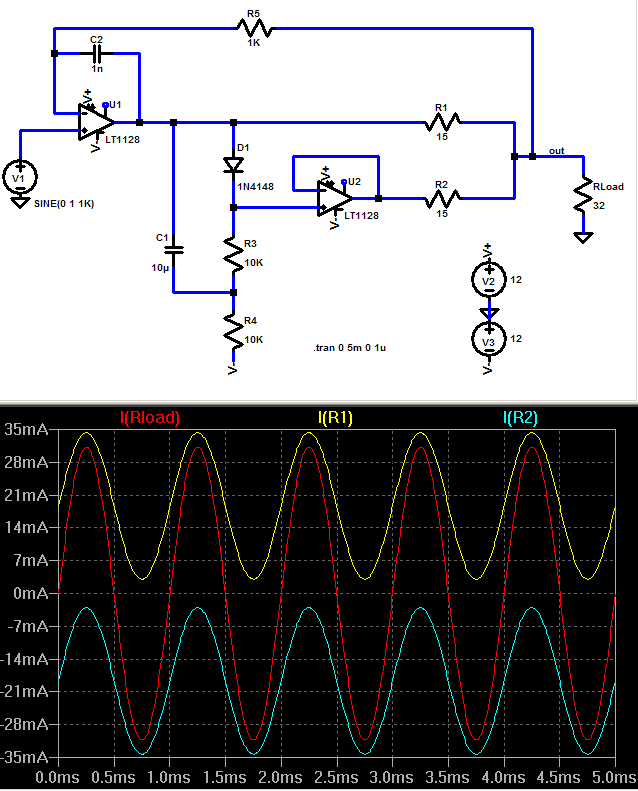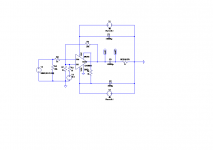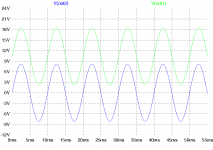Oi!
MyRef
LM1875
Driver chip
In that order.
And definitely not that car chip from Phillips (sounds like antique ab transistor amp, not a class a amp), that thing is really great on TV, but it is not a penultimate for music; so, you might want to define the purpose before trying that (efficient, yes extremely, but really not smooth class a sound).
P.S.
Problematically, you must not put more power into an LM1875 than it could output (sum heatsink and speaker), which is monoblocs with 36va transformers if you want it to last. This is not expensive, but does take some care with the figures, some DIY and a lotta caps. The MyRef Fremen would be somewhat similar for tone and a lot more durable, especially when it comes to madness transformer VA figures (which would merely cause the LM3886 to attempt outputting the SPIKE system's hard clipper screech, then handily defeated by the MyRef's small signal override chip--NICE!!). So, transformer VA figures that would cause the LM1875 to break, will do nothing to the MyRef. Try the MyRef Fremen Edition. The other options will not successfully resist all of the conflicting advices posted online; however, the MyRef Fremen will work. It is a Howland Current Pump, and so the tone may indeed resemble what you think Class A should do. Probably.
MyRef
LM1875
Driver chip
In that order.
And definitely not that car chip from Phillips (sounds like antique ab transistor amp, not a class a amp), that thing is really great on TV, but it is not a penultimate for music; so, you might want to define the purpose before trying that (efficient, yes extremely, but really not smooth class a sound).
P.S.
Problematically, you must not put more power into an LM1875 than it could output (sum heatsink and speaker), which is monoblocs with 36va transformers if you want it to last. This is not expensive, but does take some care with the figures, some DIY and a lotta caps. The MyRef Fremen would be somewhat similar for tone and a lot more durable, especially when it comes to madness transformer VA figures (which would merely cause the LM3886 to attempt outputting the SPIKE system's hard clipper screech, then handily defeated by the MyRef's small signal override chip--NICE!!). So, transformer VA figures that would cause the LM1875 to break, will do nothing to the MyRef. Try the MyRef Fremen Edition. The other options will not successfully resist all of the conflicting advices posted online; however, the MyRef Fremen will work. It is a Howland Current Pump, and so the tone may indeed resemble what you think Class A should do. Probably.
Last edited:
Parveen247,
There are no single chip class A amplifiers available or somebody here would have built one. We were suggesting configuring a Class AB chip as class A. It might give you an amp capable of 1/10 of its normal power output.
Not recommended for first time builders.
There are no single chip class A amplifiers available or somebody here would have built one. We were suggesting configuring a Class AB chip as class A. It might give you an amp capable of 1/10 of its normal power output.
Not recommended for first time builders.
Last edited:
Mark? What do you think of a class a voltage amp (somewhat sturdy small signal op amp) nested to a chip current buffer (TDA7293's in slave mode)? I'm fairly sure the small signal voltage amp would copy its sonic signature over top of the power buffer quite easily; however, I've absolutely no idea how it would be better than the MyRef Fremen audibly.
Perhaps tubes or jfets pushing those chip power buffers could be a bit interesting, especially if the power buffer's bootstrap were eliminated although they can only do 45 watts that way. Even so, 45 watts of Class A sound at near Class AB efficiency could be interesting. The voltage amp is really what gets the sonic signature because it puts gain on that. The concept is fascinating although there may be a good reason why it has not yet been done. . .
You know what? Exploiting the NE5534's expansion capacity might work--jfet input with driver output, the whole thing (barely documented rarely) could serve as driver to TDA7293's in slave mode, in which case, you'd have top class input, top class vas, your choice of drivers and fet output devices all in one amplifier, mostly chips. However, the documentation is mostly lost. Perhaps a well rigged driver chip pushing the power buffers instead?
Perhaps tubes or jfets pushing those chip power buffers could be a bit interesting, especially if the power buffer's bootstrap were eliminated although they can only do 45 watts that way. Even so, 45 watts of Class A sound at near Class AB efficiency could be interesting. The voltage amp is really what gets the sonic signature because it puts gain on that. The concept is fascinating although there may be a good reason why it has not yet been done. . .
You know what? Exploiting the NE5534's expansion capacity might work--jfet input with driver output, the whole thing (barely documented rarely) could serve as driver to TDA7293's in slave mode, in which case, you'd have top class input, top class vas, your choice of drivers and fet output devices all in one amplifier, mostly chips. However, the documentation is mostly lost. Perhaps a well rigged driver chip pushing the power buffers instead?
Last edited:
Let's hope this doesn't turn into a Class A vs Class A/B slanging match.
If you want to venture into Class A without spending a fortune you could try JLH 10W, Hiraga or one of the Pass designs (such as the F5).
Class A will always be more expensive to build than Class A/B due to the PSU and heatsink requirements but, in my opinion, the cost is well worth it.
If you want to venture into Class A without spending a fortune you could try JLH 10W, Hiraga or one of the Pass designs (such as the F5).
Class A will always be more expensive to build than Class A/B due to the PSU and heatsink requirements but, in my opinion, the cost is well worth it.
Last edited:
I suppose any method that would give you a large offset.
1. Add to the input audio signal a DC voltage. make it variable together with the input pot.
or
2. Place a Class A pre amp before the opamp.
or
3. Add/replace Ci with a voltage source. producing offset, instead of preventing offset.
or
I did not consider removing the dif. inputs and feedback. But I did think of using 200k and 10k feedback resistors, reducing the feedback current.
The max power output might not be as low as I first thought. but could not be higher than 1/2. Using only half of the output stage.
I am sure I have made quit a few wrong assumptions, just some ideas.
1. Add to the input audio signal a DC voltage. make it variable together with the input pot.
or
2. Place a Class A pre amp before the opamp.
or
3. Add/replace Ci with a voltage source. producing offset, instead of preventing offset.
or
I did not consider removing the dif. inputs and feedback. But I did think of using 200k and 10k feedback resistors, reducing the feedback current.
The max power output might not be as low as I first thought. but could not be higher than 1/2. Using only half of the output stage.
I am sure I have made quit a few wrong assumptions, just some ideas.
+1. The JLH 10 Watt class A amplifier is probably the simplest to build - a PCB and parts kit can be had from the usual auction site for less that $20 USD You still need to add a powersupply and heatsinks.If you want to venture into Class A without spending a fortune you could try JLH 10W, Hiraga or one of the Pass designs (such as the F5).
[Edit - for $40 you can get it pre-assembled!]
Last edited:
some major "details" need to be attended to to make it work with power audio chip amps -
...I explained some Class A push-pull op amp output bias concepts in my (jcx) posts:
AD8397-class A?
... higher power class A amps could be made similarly with "GainClone" power audio amp chips which are monolithic power op amps
simplified Class A push-pull output bias circuit:

What about TDA2050 ? its sound quality ?
Not sure about your expertise in building amps. However I'd suggest you build a TDA2050 which is "very good" for the overall expense. Remember that the chip itself is only a very small fraction of the overall ( material!) cost of the amp.
Besides this your source ( CD player , DAC etc.) and loudspeaker and room acoustics play a VERY large role in what you hear. A poor source will not give you the sound you want. In addition you need to remember the most import item here is the quality of the recorded sound ! Everything starts with that.
So if everything else mentioned above is perfect, the TDA2050 WILL sound very good ! Build that and then move on to a class A amp later on. That will need FAR more effort and MUCH more expense and time ! Most likely it will also be fraught with lots of build issues. Just look at the other class A amp threads on this forum and you will understand.
Best of luck .
No. It is just a DC coupled amp with a deliberately introduced DC offset that will cause asymmetric clipping and require the use of an output cap.
The idea is to prevent the crossover distortion. The DC offset can be adjusted as needed to prevent clipping.
Use three PSU's. High current supply is needed for the pos. rail. The neg. rail only needs a low current supply. For the DC offset 5V is probably ok.
Use three PSU's. High current supply is needed for the pos. rail. The neg. rail only needs a low current supply. For the DC offset 5V is probably ok.
The idea is to prevent the crossover distortion. The DC offset can be adjusted as needed to prevent clipping.
Use three PSU's. High current supply is needed for the pos. rail. The neg. rail only needs a low current supply. For the DC offset 5V is probably ok.
It won't work for the simple reason that the idea always needs a speaker coupling cap to remove the offset from the load. As soon as you add that, the same crossover distortion will reappear. Without the cap and the distortion vanishes, but only because of the large DC current now flowing either into or out of the amp, the polarity depending on the offset.
Don't most Class A headphone amps use this method?
I don't see how the Cap causes crossover distortion. Maybe some reduction of LF gain and phase shift.
I don't see how the Cap causes crossover distortion. Maybe some reduction of LF gain and phase shift.
Don't most Class A headphone amps use this method?
I haven't seen any that deliberately introduce an offset. Many small amps can source or sink a permanent standing current into or out of the amplifier output terminal, and that forces the amp into class A within the limits of the available current. In that case, the amplifier still holds its DC conditions, the output is still at zero volts DC and the load can be either AC or DC coupled.
I don't see how the Cap causes crossover distortion. Maybe some reduction of LF gain and phase shift.
It doesn't. What it does do is block the steady DC current that would flow in the load. That current if allowed (so no cap) forces the amp into class A, so no crossover distortion but there is a large steady DC current flowing in the load. Fit the cap and that current falls to zero, and the distortion returns.
Short answer, no, not unless we're talking about poor topology, parts or construction of a Class A amp.
Let alone Class A, I don't think any chips come close to good discrete designs either (again, key word being good).
Keep your expectations realistic. A chip amp is typically made with a budget of about $0.25 to $0.50, the LM3886 and similar chips may be a little more. The designer has lots and lots of compromises to work with, most of them thermal limitations of a small package. A 3886, for example, must dissipate about 30 to 40 watts worst case through a die not much bigger than a TO-247 transistor. What saves it is the fact that music signals have a very high ratio of peak to average power, and its inbuilt protection.
At the same time given the effort and cost to build a chipamp, you can get very good sound indeed. Just start building and comparing. That's the only way you will be able to actually understand it.
Let alone Class A, I don't think any chips come close to good discrete designs either (again, key word being good).
Keep your expectations realistic. A chip amp is typically made with a budget of about $0.25 to $0.50, the LM3886 and similar chips may be a little more. The designer has lots and lots of compromises to work with, most of them thermal limitations of a small package. A 3886, for example, must dissipate about 30 to 40 watts worst case through a die not much bigger than a TO-247 transistor. What saves it is the fact that music signals have a very high ratio of peak to average power, and its inbuilt protection.
At the same time given the effort and cost to build a chipamp, you can get very good sound indeed. Just start building and comparing. That's the only way you will be able to actually understand it.
Removed by me, because its not relevant to opening post. Maybe I will start a new thread.
Attachments
Last edited:
..... is there any chip amp that sound quality is comparable to class a amp........
......... i wants to build a cheap IC amp [15 Watts to 50 Watts] that gives good sound quality...............
If you have compared IC amp with class a [in sound quality] then please mention...........
This was the original post.
He 'wants' to build a 'cheap' chip amp which sounds good !
The answer to his first question is ..NO .
The answer to the second question is...Yes, an IC power amp does not sound as good as a good class A amp .
QED.....maybe !🙂
Elvee has a pair of discrete amplifiers that are an easy build. The Circlophone (Class AA) and the Tringlophone (Class A).
Technically, darlington's are IC chips and thus Circlophone Darlington Version is one possible answer to a Class A amplifier with chips (although it is actually Class AA with darlingtons). That version is actually fairly easy to build.
Technically, darlington's are IC chips and thus Circlophone Darlington Version is one possible answer to a Class A amplifier with chips (although it is actually Class AA with darlingtons). That version is actually fairly easy to build.
- Status
- Not open for further replies.
- Home
- Amplifiers
- Chip Amps
- Chip amp comparable to class a sound


